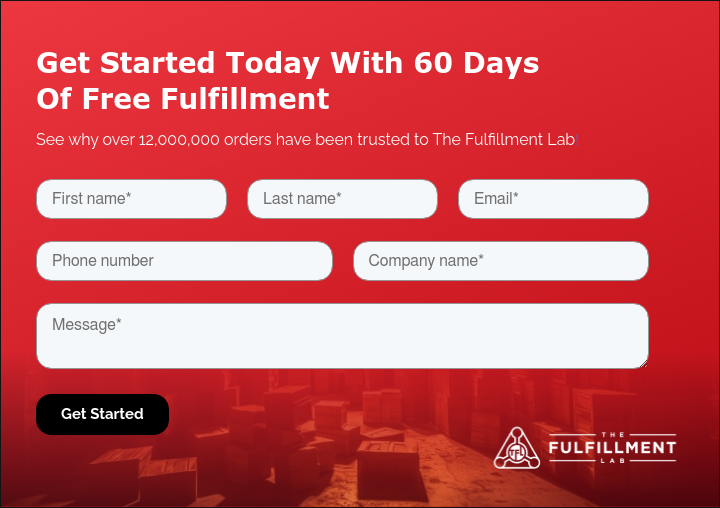10 Shipping Options for Small Business
Small business owners are also great jugglers. In addition to hustling to acquire new customers, they are also managing manufacturing, marketing, finances, and more each and every single day. One area that many small business owners are also focused on is shipping. Specifically, they'll ask "what is the best shipping company for small businesses?" and "which shipper will get their products to my customers quickly and affordably?" After all, studies show that shipping costs (and the availability of free shipping) impact the purchase decisions of more than 50% of U.S. consumers.
In this blog, we’ll look at which carriers small business owners can use, how to choose the right packaging and materials, and how the location of their customers can impact these choices.
Best Shipping for Small Business: Top 10 Considerations
Are you wondering how to get the best shipping rates for small business? Or, are you looking for a 3PL partner and want to know which is the best shipping company for small businesses? We're here to help! Choosing a shipping strategy will ultimately depend on the needs of your business. Here are a few factors that need to be kept in mind when choosing your small business shipping solution.
1. Order Volume
You’re not moving products as quickly as the big guys like Amazon – yet! So, in the meantime, it’s important to consider the number of orders you ship each month. If you’re still getting your feet wet and shipping a low volume of products, going the DIY route – buying packages, printing labels, and going to the post office – is probably the best option.
However, if your order volume is continuing to increase month over month, you might want to consider an eCommerce fulfillment solution that can take the shipping burden off your shoulders and offer shipping discounts.
2. Delivery Time
Most consumers are impatient; when they place an order online, they expect it to arrive in a timely manner—unless it's a custom product or coming in from overseas. So, how quickly a carrier can get your product to the enduser is a big consideration.
Of course, there are times you may want to make an exception to speed. For example, if you want to offer free shipping, you may need to choose a slower, less expensive shipping method so that you don't break your budget.
3. Packaging Material
Flat-rate boxes through the USPS, UPS or FedEx are an obvious choice for shipping some items. However, you must consider your product’s fragility. If it is fragile (like glassware or some ceramics), it will need more packaging material than say, a T-shirt.
On the other hand, maybe you’re looking to really showcase your brand through customized packing. In that case, even a T-shirt may need some eye-catching packaging in the form of colored boxes and inserts that these services don’t typically offer.
4. Package Dimensions
How bulky are your products? Dimensional weight, or DIM, takes into account the size of your shipment when calculating costs. Of course, the larger the item, the larger the box, which means a greater DIM. Add to that the bulk of air-fill cushions, bubble wrap, or styrofoam peanuts, and the cost increases even more.
5. Package Weight
The heavier the package, the greater the cost (unless you’re using flat-rate shipping). If you’re still in a DIY mindset, purchasing a postage scale for your “shipping center,” be it a bedroom or a garage, will help you to predict costs more accurately.
6. Shipping Destination
Is your package traveling within the country or across the sea? Distance, of course, is a big consideration that impacts shipping rates. It also factors into how quickly you can get your product to a customers’ doorstep. While startups may have no choice but to accept the costs, other small businesses can take advantage of fulfillment centers that are more centrally located. More on this in a moment!
7. Package Tracking
You want to know where your package is on every leg of its journey. Choose a carrier that offers free package tracking online; some will even give you automatic updates via text or email. You can also provide tracking information to the customer so that they're able to follow the product's journey as well; this can keep them from wondering where it's at, especially if it's a lengthy delivery time.
8. Fragile Items
Shipping something breakable? You'll want a sturdy box that can support the weight of your item (your best bet is probably a rigid box or a corrugated box with large flutes; you can read more about these box is our blog Six Types of Custom Packaging). You'll also need cushioning material that will help restrict items from moving. Remember to always pack fragile items individual, seal the box tightly, and mark it as "fragile."
9. Perishable Items
Shipping perishable items used to be restricted to local and regional customers, but today they can be shipping worldwide with expedited delivery. Perishable items traveling within the United States must be able to withstand a minimum transit time of 24 hours greater than the delivery commitment.
You can use a refrigerant that will keep products within your required temperature range. FedEx states that use should use gel coolants for refrigerating products between 32ºF (0ºC) and 60ºF (16ºC) and dry ice for frozen items.
10. Third-Party Insurance
Insuring your shipments is a wise move, but it can get expensive when using the carrier's insurance. Instead, you might consider using third-party insurance. While carriers typically charge about $1 per $100 of insurance, a third-party insurance company is typically half that price. You can read more from small business owners like you looking for third-party insurance on this forum.
4 Carriers for Shipping Services for Small Businesses
If you’re following a DIY shipping program, there are four main carriers to choose from. Each carrier has some version of a small business shipping solution. Here’s a look at the different options, then it's up to you to determine which offers the best shipping rates for your small business.
1. USPS
USPS shipping offers a free Priority Mail Starter Kit for small businesses which allows you to set up a PO box. For low-volume shippers, there are also a number of programs that make it easier to fulfill orders in-house, such as Click-N-Ship. This program allows you to purchase postage and print shipping labels online. There’s also a home pickup option for those who can’t make frequent trips to the post office.
Last-mile delivery is another USPS shipping benefit, which supports the transportation of a package to its final destination quickly and cost-effectively. Additionally, USPS provides a certificate of mailing for most shipping services.
2. FedEx
As its name implies, FedEx Small Business is geared towards startups. The program offers numerous benefits, including a rewards program and the Packaging Help Hub, a resource that helps you calculate package DIM. Are you shipping perishables? FedEx also offers temperature-controlled shipping.
3. UPS
UPS has a Small Business Program that offers a variety of resources to small business owners. Along with providing the ability to schedule pickups and manage customer returns, UPS allows you to participate in virtual brainstorming sessions with their small business solutions team. They can help you map out and fine-tune your supply chain, discover opportunities for greater agility, productivity, and growth, and discuss other tools and services that will help accelerate your business.
4. DHL
Shipping overseas? DHL is ideal for international express deliveries and global freight forwarding by air, sea, road, and rail. The company also has small businesses shipping options and will help you choose the right service and take care of all customs handling. They also provide full visibility on the status of your shipments at all times.
Using a Multi-Carrier Shipping Strategy
With four major carriers to choose from, how do you know which is best for your business? Often, busy shippers will simply choose a single carrier strategy and negotiate a reasonable rate. This streamlines decision making, as there’s no need to research rates online or request a spot quote. Despite the time-saving benefit of the single carrier approach, you may also want to consider multi-carrier shipping solutions.
5 Advantages of Small Business Shipping When Relaying Multiple Carriers
While a single carrier strategy is a time-saver, using multiple shipping carriers offers five benefits of its own.
1. Gaining More Negotiating Power
As an eCommerce business owner, you can often negotiate a better rate than the average joe may get with a single carrier. However, it still leaves you at the mercy of that carrier and can leave you a bit complacent. That’s because many shippers in an exclusive agreement with a carrier don’t keep up with the types of services that other carriers offer if they’re current carrier is generally meeting expectations. In addition, carriers may not offer existing customers their most competitive service options or rates, similar to cable companies.
So, even though you’ve had a relationship with a carrier for years, a new shipper could come in and get a better rate! Then, if you decide to ship to another carrier, you’ll be forced to do rate research, negotiate a new deal, and sign new agreements, all of which can be time-consuming.
With a multiple carrier strategy, you gain more negotiating power because carriers also know they need to earn your business on every shipment. They’re also likely to keep you informed about new rates, routes, service types, and service levels, so you’re always getting the best deals in town.
2. Choosing the Right Carrier for the Right Job
While a single carrier strategy can save time because you always know who you’re going to ship with, not all carriers are created equally. When it comes to handling different types of shipments, some carriers are just better than others.
So, following a multi-carrier shipping approach, you would choose the carrier that’s best suited for each particular shipment (for example, domestic vs. international shipping, oversized shipments, etc.). Again, this can be time consuming, but the payoff may be worth it.
3. Mitigating Risks
Entrusting all your shipments to one carrier is a lot like putting all your eggs in one basket. If something goes wrong, you don’t have a backup. And of course, shipping involves quite a bit of risk. A carrier may change service levels, for example, or discontinue service to certain areas, leaving you scrambling to find another carrier. You may find that your carrier is becoming sloppy, losing more and more packages in transit. Or, Inclement weather could also bring a carrier to its knees, which then impacts your ability to ship product in a timely fashion. For these reasons, it’s always a good idea to have a plan B (i.e., a deal with another carrier).
4. Accommodating Customer Requests
Sometimes, a customer may have a preferred carrier. For example, a customer may prefer one carrier over another because they offer services like pick-up/drop-off (PUDO). If that carrier isn’t available, they may abandon their cart (shipping issues account for 86% of all abandoned carts). Or, a B2B customer may ask you to ship their packages to them on their own account.
If you have an exclusive agreement with a single carrier, you won’t be able to accommodate these requests, which could cost you a customer. If you go to another carrier and break your exclusivity agreement in order to accommodate the request, you may be penalized with higher shipping rates in the future or lose your preferred shipper status. However, if you’re operating under a multi-carrier strategy, none of this will be an issue and you’ll be able to accommodate your customers’ requests.
5. Greater Flexibility with Returns
It’s estimated that 30% of all products ordered online are returned (compared to less than 8% of products purchased at brick-and-mortar stores). This makes returns management critical for eCommerce businesses. However, while carriers may be comparable at shipping outbound packages, some may be better than others when it comes to reverse logistics. Then again, those that do excel at reverse logistics may have a higher shipping rate.
When using multiple carriers, eCommerce businesses may choose to use a competitively-priced carrier that’s less adept at managing reverse logistics for products that are not returnable, or that are rarely returned. Then, for products that are typically returned (this will require some historical analysis), they may choose a more expensive carrier that excels at reverse logistics.
5 Ways to Reduce Shipping Costs
Choosing a provider is one thing; finding ways to reduce shipping costs is another! Here are five ways that small businesses may be able to reduce their shipping costs without going cheap.
1. Pick-up vs. Drop Off
Major carriers will schedule pickups from your home to save you the hassle of visiting their storefront. USPS provides this service for free, while UPS and FedEx both charge a small fee. It’s up to the small business owner to decide if the fee offsets the time wasted going to and from a shipping destination.
2. Negotiating Rates
Wondering how to get cheap shipping for small business? Well, the more you ship, the more you save! Generally, if you’re moving more than 100 orders per month, a carrier will be willing to negotiate better pricing to keep your business (this may require an exclusivity agreement, however, which would eliminate your ability to choose a multi-carrier approach). To learn more, you should contact the various carriers and ask about the required quantities for them to offer lower rates and whether exclusivity is a requirement.
3. Choosing Affordable Packing Materials
The cost of boxes, bubble wrap, air-fill cushions, and styrofoam peanuts can quickly add to your shipping expenses. You may consider reusing boxes, however you need to know that reused boxes tend to lose about 60% of their strength and even the slightest bit of damage can compromise their integrity. If you’re not concerned with branding, you can buy these items in bulk to save; otherwise, using a fulfillment warehouse that specializes in this may be your best bet.
4. Know Your Shipping Zones
Whenever a package is sent from one location to another, it will cross through one or more shipping zones. The more zones a package travels, the more money you'll pay in shipping. Knowing your shipping zones is crucial when negotiating shipping rates with carriers. Want to learn more? Check out our blog How Shipping Zones Might Affect Fulfillment.
5. Outsourcing vs. In-House Fulfillment
Small businesses that are growing may want to consider a third-party logistics provider, or 3PL. These centers will store your inventory, pack your orders properly, and prepare them to be picked up by carriers. Many 3PLs such as The Fulfillment Lab will also take care of returns management and have discounted shipping arrangements in place with carriers so that they can pass the savings on to you.

Small Business Shipping Solutions with The Fulfillment Lab
As your business grows, storage, packing, and shipping can become a real problem. That’s where we come in. We have multiple domestic and international locations, which means we can reduce shipping costs and increase delivery speeds by minimizing the number of shipping zones your package has to cross (shipping rates are often determined by zones).
Never worry about inventory management again when you work with the leading 3PL partner in the eCommerce space. We provide kitting services, fast shipping, and more.
That’s not all. If you’re looking to boost your brand’s recognition – something that’s very important to many small businesses – we offer fulfillment marketing, shipping and wrapping your product in materials that fit your unique customer demographics. To learn more about The Fulfillment Lab and why we are the best shipping company for your small business, visit us online or contact us today.




